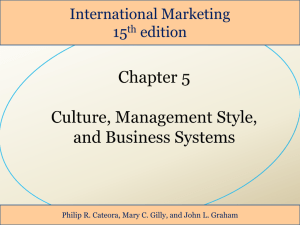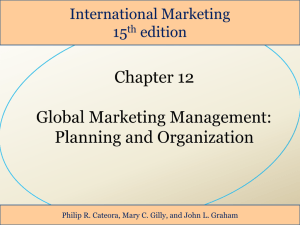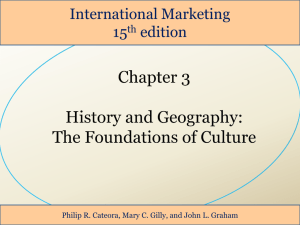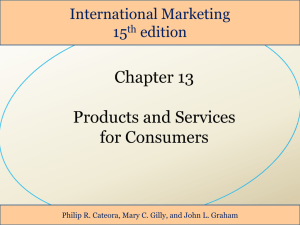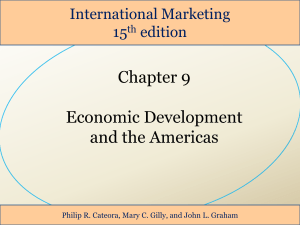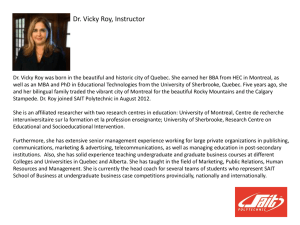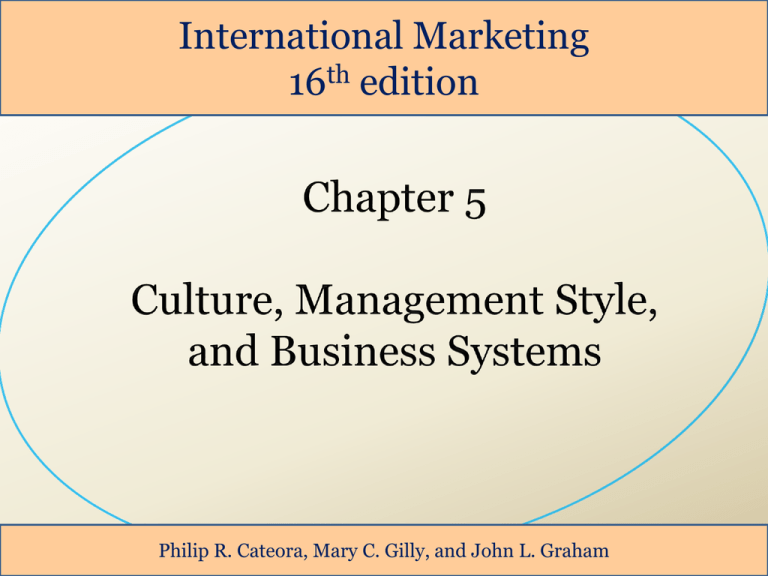
International Marketing
16th edition
Philip R. Cateora, Mary C. Gilly, and John L. Graham
Introduction (1 of 2)
5
• Culture, including all of its elements, profoundly
affects management style and overall business
systems
• Culture not only establishes the criteria for dayto-day business behavior but also forms general
patterns of values and motivations
• Various studies have identified North Americans
as “individualists,” Japanese as “consensus
oriented,” and Europeans as “elitists and rank
conscious”
Roy Philip
2
Introduction (2 of 2)
5
• A lack of empathy for and knowledge of foreign
business practices can create insurmountable
barriers to successful business relations
• Knowledge of the management style – the
business culture, management values, and
business methods and behaviors existing in a
country and a willingness to accommodate the
differences are important to success in an
international market
• Culture has an important influence on strategic
thinking
Roy Philip
3
Overview
5
• The necessity for adapting to cultural differences
with imperatives, electives, and exclusives
• Different management styles vary around the
world
• The extent and implications of gender bias in
other countries
• The importance of cultural differences in
business ethics
• The differences between relationship-oriented
and information-oriented cultures
Roy Philip
4
Global Perspective
5
Do Blondes Have More Fun in Japan?
• Very odd in Japan to see a woman, who is blonde,
young, and very tall by Japanese standards, leading
business negotiations
• The Japanese would not even look at the lead
negotiator because she was a woman
• Mattell Inc. research showed that the original
Barbie, with her yellow hair and blue eyes, played as
well in Hong Kong as it did in Hollywood
• But this standardized approach taken by Mattell
caused sales to plummet
Roy Philip
5
Videos
5
• Chinese Ideas of Contracts
• Touching in India?
• Special Holiday in India - Diwali?
Roy Philip
6
International Marketing
16th edition
McGraw-Hill/Irwin
Copyright © 2011 by The McGraw-Hill Companies, Inc. All rights reserved.
Required Adaptation
5
• Adaptation is a key concept in international
marketing
• Ten basic criteria for adaptation
1) Open tolerance
2) Flexibility
3) Humility
4) Justice/fairness
5) Ability to adjust to varying tempos
6) Curiosity/interest
7) Knowledge of the country
8) Liking for others
9) Ability to command respect
10) Ability to integrate oneself into the environment
Roy Philip
8
Degree of Adaptation
5
• Essential to effective adaptation
– Awareness of one’s own culture and the
– Recognition that differences in others can cause
anxiety, frustration, and misunderstanding of the
host’s intentions
• The self-reference criterion (SRC) is especially
operative in business customs
• The key to adaptation is to remain American but
to develop an understanding of and willingness
to accommodate the differences that exist
Roy Philip
9
International Marketing
16th edition
McGraw-Hill/Irwin
Copyright © 2011 by The McGraw-Hill Companies, Inc. All rights reserved.
Imperatives, Electives,
and Exclusives
5
• Cultural imperatives - Business customs and
expectations that must be met and conformed to or
avoided if relationships are to be successful
– In some cultures a person’s demeanor is more critical than
in others
– Imperatives vary from culture to culture
• Cultural electives - Relate to areas of behavior or to
customs that cultural aliens may wish to conform to or
participate in but that are not required
– A cultural elective in one county may be an imperative in
another
• Cultural exclusives - Customs or behavior patterns
reserved exclusively for the locals
Roy Philip
11
BEIJING, CHINA: German Chancellor Angela Merkel and Chinese Prime Minister Wen Jiabao
toast after the EU–China Business Summit at the Great Hall of the People in Beijing. The
summit was boosted by the settlement of a trade row that had left 80 million Chinese-made
garments piled up in European seaports, unable to be delivered to shops under a quota pact
agreed to at the time. Drinking half a bottle is a cultural elective, but taking a sip is more of
an imperative in this case.
5-12
5-13
International Marketing
16th edition
McGraw-Hill/Irwin
Copyright © 2011 by The McGraw-Hill Companies, Inc. All rights reserved.
The Impact of American Culture
on Management Style
5
• “Master of destiny” viewpoint
• Independent enterprise as the instrument
of social action
• Personnel selection and reward based on
merit
• Decisions based on objective analysis
• Wide sharing in decision making
• Never-ending quest for improvement
• Competition producing efficiency
Roy Philip
15
International Marketing
16th edition
McGraw-Hill/Irwin
Copyright © 2011 by The McGraw-Hill Companies, Inc. All rights reserved.
Management Styles
around the World
•
•
•
•
•
•
•
5
Authority and decision making
Management objectives and aspirations
Communication styles
Formality and tempo
P-time versus M-time
Negotiation emphasis
Marketing orientation
Roy Philip
17
Authority and Decision Making
5
• Influencers of the authority structure of
business:
– High PDI Countries
• Mexico, Malaysia
– Low PDI Countries
• Denmark, Israel
• Three typical authority patterns:
– Top-level management decisions
– Decentralized decisions
– Committee or group decisions
Roy Philip
18
Management Objectives
and Aspirations
5
• Security and mobility
– Relate directly to basic human motivation and
therefore have widespread economic and social
implications
• Personal life
– Worldwide study of individual aspirations, (David
McClelland)
• Affiliation and social acceptance
– In some countries, acceptance by neighbors and
fellow workers appears to be a predominant goal
within business
• Power and achievement - South American countries
Roy Philip
19
Annual Hours Worked
5
Exhibit 5.1
Roy Philip
20
Insert Exhibit 5.1
Annual Hours Worked
Source: OECD, Labor Market Indicators, 2012.
5-21
Communication Styles
5
• Face-to-face communication
– Managers often fail to develop even a basic understanding of just
one other language
– Much business communication depends on nonverbal messages
• Internet communications
– Nothing about the Web will change the extent to which people
identify with their own language and cultures
• 78% of today’s Web site content is written in English
• An English e-mail message cannot be understood by 35% of
all Internet users
– Country-specific Web sites
– Web site should be examined for any symbols, icons, and other
nonverbal impressions that could convey and unwanted message
– www.nike.com – a great example of a company with a webpage
for many countries
Roy Philip
22
American Slangs –
Foreign Interpretations
• “Let’s do a deal”
• “What’s the bottom line?”
• “Okay” or “That’s okay”
• “That’s a shame”
• “I get a kick from that”
• “Can we close on this?”
• “That is too good to be true”
5
• Arab=“Let’s do something
unethical”
• Japanese=“What is your
starting bid?”
• Chinese “Not really good,
could be better”
• Indian=“You have insulted
me”
• Japanese= “It hurts”
• Chinese= “We should stop,
cancel this”
• Malaysian= “You must be
cheating me”
Roy Philip
23
Formality and Tempo
5
• Breezy informality and haste characterize
American business relationships
• Europeans not necessarily “Americanized”
• Higher on Hofstede’s Power Distance Index
(PDI)
– May lead to business misunderstandings
• Haste and impatience most common mistakes
made by Americans in the Middle East
• For maximum success marketers must deal with
foreign executives in acceptable ways
Roy Philip
24
Contextual Background
of Various Countries
5
Exhibit 5.2
Roy Philip
25
5-26
P-Time versus M-Time
5
• Monochronic time
– Tend to concentrate on one thing at a time
– Divide time into small units and are concerned with
promptness
– Most low-context cultures operate on M-Time
• Polychronic time
– Dominant in high-context cultures
– Characterized by the simultaneous occurrence of many
things
– Allows for relationships to build and context to be
absorbed as parts of high-context cultures
• Most cultures offer a mix of P-time and M-time behavior
• As global markets expand more businesspeople from
P-time cultures are adapting to M-time.
Roy Philip
27
Speed is Relative
5
Exhibit 5.3
Roy Philip
28
Negotiations Emphasis
5
• Business negotiations are perhaps the most
fundamental business rituals
• The basic elements of business negotiations are
the same in any country
– They relate to the product, its price and terms,
services associated with the product, and finally,
friendship between vendors and customers
• One standard rule in negotiating is “know
thyself” first, and second, “know your
counterpart”
Roy Philip
29
Marketing Orientation
5
• The extent of a company’s market orientation
has been shown to relate positively to profits
• Firms in other countries have not been able to
move from the traditional production, product,
and sales orientation to the marketing
orientation
• Research has shown that sometimes in can be
difficult to encourage a marketing orientation
across diverse business units in global
companies
Roy Philip
30
Gender Bias
in International Business
5
• Women represent less than 20% of the employees who
are chosen for international assignments
• In many cultures (Asia, Middle East, Latin America)
women not typically found in upper levels of
management, and are treated very differently from men
• Prejudices toward women in foreign countries
• Cross-mentoring system instituted by Lufthansa
• Executives who have had international experience are
– more likely to get promoted,
– have higher rewards, and have
– greater occupational tenure
Roy Philip
31
5-32
Female Directors on
Corporate Boards
5
Exhibit 5.4
Roy Philip
33
5-34
Business Ethics
5
• Business ethics is complex in the
international marketplace because value
judgments differ widely among culturally
diverse groups
• Corruption varyingly defined from culture
to culture
Business Ethics
Corruption
5
• What is Corruption?
–
–
–
–
–
–
Profits (Marxism)
Individualism (Japan)
Rampant consumerism (India)
Missionaries (China)
Intellectual property laws (Sub-Sahara Africa)
Currency speculation ( Southeast Asia)
• Criticisms of Mattel and Barbie
– Sales of Barbie declined worldwide after the global
standardization
– Parents and government did react
– Mattel’s strategy boosted sales of its competition
Roy Philip
36
The Western Focus on Bribery
5
• In the 1970s, bribery became a national issue with
public disclosure of political payoffs to foreign
recipients by U.S. firms
• The decision to pay a bribe creates a major conflict
between what is ethical and proper and what is
profitable and sometimes necessary for business
• The Organization for Economic Corporation and
Development (OECD) and Transparency
International (TI) are combating the bribery of
foreign public officials in international business
transactions
Roy Philip
37
Transparency International
Corruption Perception Index
5
Exhibit 5.5
Roy Philip
38
Transparency International
Transparency International - USA
5-39
5-40
Transparency International
Bribe Payer’s Index
5
Exhibit 5.6
Roy Philip
41
International Marketing
16th edition
McGraw-Hill/Irwin
Copyright © 2011 by The McGraw-Hill Companies, Inc. All rights reserved.
Bribery –
5
Variations on a Theme (1 of 2)
• Bribery and Extortion
– Bribery is voluntary offered payment by someone seeking
unlawful advantage is bribery
– Extortion takes place only if payments are extracted under
duress by someone in authority from a person seeking only what
he or she is lawfully entitled to
• Subornation and Lubrication
– Subornation involves giving large sums of money, frequently not
properly accounted for, designed to entice an official to commit
an illegal act on behalf of the one offering the bribe
– Lubrication involves a relatively small sum of cash, a gift, or a
service given to a low-ranking official in a country where such
offerings are not prohibited by law
– Bribery in India; Bribery in India (part II)
Roy Philip
43
Bribery –
5
Variations on a Theme (2 of 2)
• Agent’s Fees
– When a businessperson is uncertain of a country’s
rules and regulations, an agent may be hired to
represent the company in that country
– The Foreign Corrupt Practices Act (FCPA)
– Change will come only from more ethically and
socially responsible decisions by both buyers and
sellers and by governments willing to take a stand
• Since 1994, US businesses have bowed out of 294
major overseas commercial contracts valued at
$145 billion rather than paying bribes
5-44
Ethical and Socially
Responsible Decisions
•
Difficulties arise in making decisions, establishing policies, and
engaging in business operations in five broad areas
–
–
–
–
–
•
•
5
Employment practices and policies
Consumer protection
Environmental protection
Political payments and involvement in political affairs of the country
Basic human rights and fundamental freedoms
Laws are the markers of past behavior that society has deemed
unethical or socially irresponsible
Ethical principles to help the marketer distinguish between right
and wrong, determine what ought to be done, and justify actions
–
–
–
Utilitarian Ethics (Does it achieve a common good?)
Rights of the Parties (Does the actions involve the rights of the
individual?)
Justice or Fairness (Does the action represent fairness for all?)
Roy Philip
45
Culture’s Influence
on Strategic Thinking
5
• British-American
– Individualistic
• Japan & Germany
– Communitarian
• In the less individualistic cultures labor and
management cooperate
• A competitive, individualistic approach works well in the
context of an economic boom
• Fourth kind of capitalism –
– Common in Chinese cultures
– Predicted by culture
Roy Philip
46
A Synthesis – Relationship-Oriented
vs. Information-Oriented Cultures
5
• Studies are noting a strong relationship between Hall’s
high/low context and Hofstede’s
Individualism/Collective and Power Distance indexes
• Not every culture fits every dimension of culture in a
precise way
• Information-oriented culture
– United States
• Relationship culture
– Japan
• Synthesis of cultural differences allows us to make
predictions about unfamiliar cultures
Roy Philip
47
A Framework for Ethical Principles
(1)
Utilitarian
ethics
Does the action optimize the
“common good” or benefits of all
constituencies? And, who are the
pertinent constituencies?
(2) Rights of
the parties
Does the action respect the rights of
the individuals involved?
(3) Justice or
fairness
Does the action respect the canons of
justice or fairness to all parties
involved?
5
5-49
Dimensions of Culture –
A Synthesis
5
Exhibit 5.7
Roy Philip
50
5
•
•
•
•
•
•
•
5-51
Fair and Lovely Commercial
Fairever Commercial
Fair and Lovely’s Skin Care for Men
Fair and Handsome Shah Rukh Khan
Vermillion Mark on the Forehead
Olay Skin Care
Dove Evolution
Summary (1 of 2)
5
• Some cultures appear to emphasize the importance of
information and competition while others focus more on
relationships and transaction cost reductions
• Businesspersons working in another country must be
sensitive to the business environment and must be
willing to adapt when necessary
• Understanding the culture you are entering is the only
sound basis for planning
• Business behavior is derived in large part from the basic
cultural environment in which the business operates and,
as such, is subject to the extreme diversity encountered
among various cultures and subcultures
Roy Philip
52
Summary (2 of 2)
5
• Environmental considerations significantly affect the
attitudes, behavior, and outlook of foreign
businesspeople
• Varying motivational patterns inevitably affect methods
of doing business in different countries
• The international trader must be constantly alert and
prepared to adapt when necessary
• No matter how long in a country, the outsider is not a
local – in many countries that person may always be
treated as an outsider
• Assuming that knowledge of one culture will provide
acceptability in another is a critical mistake
Roy Philip
53

